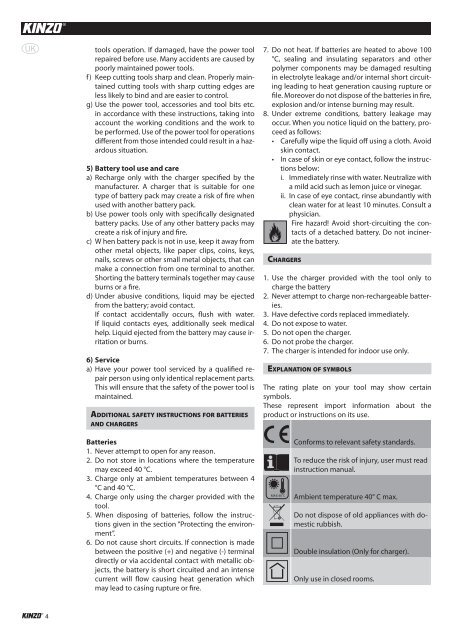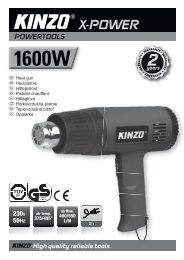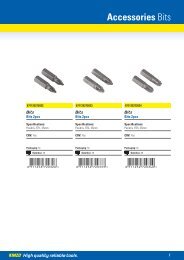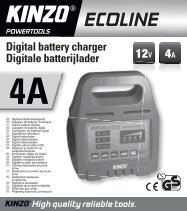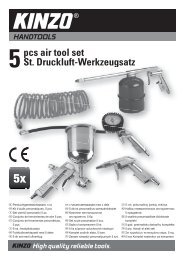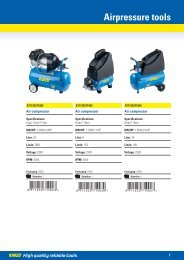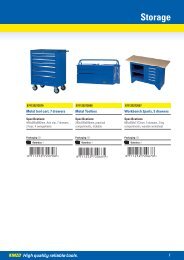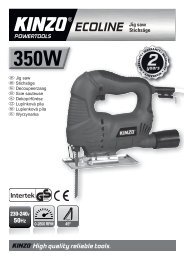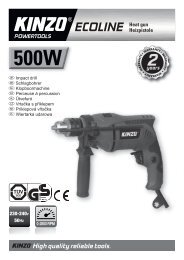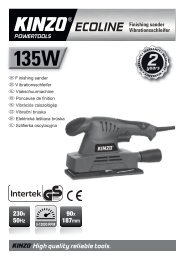Intertek - kinzo
Intertek - kinzo
Intertek - kinzo
Erfolgreiche ePaper selbst erstellen
Machen Sie aus Ihren PDF Publikationen ein blätterbares Flipbook mit unserer einzigartigen Google optimierten e-Paper Software.
A<br />
tools operation. If damaged, have the power tool<br />
repaired before use. Many accidents are caused by<br />
poorly maintained power tools.<br />
f) Keep cutting tools sharp and clean. Properly maintained<br />
cutting tools with sharp cutting edges are<br />
less likely to bind and are easier to control.<br />
g) Use the power tool, accessories and tool bits etc.<br />
in accordance with these instructions, taking into<br />
account the working conditions and the work to<br />
be performed. Use of the power tool for operations<br />
different from those intended could result in a hazardous<br />
situation.<br />
5) Battery tool use and care<br />
a) Recharge only with the charger specified by the<br />
manufacturer. A charger that is suitable for one<br />
type of battery pack may create a risk of fire when<br />
used with another battery pack.<br />
b) Use power tools only with specifically designated<br />
battery packs. Use of any other battery packs may<br />
create a risk of injury and fire.<br />
c) W hen battery pack is not in use, keep it away from<br />
other metal objects, like paper clips, coins, keys,<br />
nails, screws or other small metal objects, that can<br />
make a connection from one terminal to another.<br />
Shorting the battery terminals together may cause<br />
burns or a fire.<br />
d) Under abusive conditions, liquid may be ejected<br />
from the battery; avoid contact.<br />
If contact accidentally occurs, flush with water.<br />
If liquid contacts eyes, additionally seek medical<br />
help. Liquid ejected from the battery may cause irritation<br />
or burns.<br />
6) Service<br />
a) Have your power tool serviced by a qualified repair<br />
person using only identical replacement parts.<br />
This will ensure that the safety of the power tool is<br />
maintained.<br />
Additional safety instructions for batteries<br />
and chargers<br />
7. Do not heat. If batteries are heated to above 100<br />
°C, sealing and insulating separators and other<br />
polymer components may be damaged resulting<br />
in electrolyte leakage and/or internal short circuiting<br />
leading to heat generation causing rupture or<br />
file. Moreover do not dispose of the batteries in fire,<br />
explosion and/or intense burning may result.<br />
8. Under extreme conditions, battery leakage may<br />
occur. When you notice liquid on the battery, proceed<br />
as follows:<br />
• Carefully wipe the liquid off using a cloth. Avoid<br />
skin contact.<br />
• In case of skin or eye contact, follow the instructions<br />
below:<br />
i. Immediately rinse with water. Neutralize with<br />
a mild acid such as lemon juice or vinegar.<br />
ii. In case of eye contact, rinse abundantly with<br />
clean water for at least 10 minutes. Consult a<br />
physician.<br />
Fire hazard! Avoid short-circuiting the contacts<br />
of a detached battery. Do not incinerate<br />
the battery.<br />
Chargers<br />
1. Use the charger provided with the tool only to<br />
charge the battery<br />
2. Never attempt to charge non-rechargeable batteries.<br />
3. Have defective cords replaced immediately.<br />
4. Do not expose to water.<br />
5. Do not open the charger.<br />
6. Do not probe the charger.<br />
7. The charger is intended for indoor use only.<br />
Explanation of symbols<br />
The rating plate on your tool may show certain<br />
symbols.<br />
These represent import information about the<br />
product or instructions on its use.<br />
Batteries<br />
1. Never attempt to open for any reason.<br />
2. Do not store in locations where the temperature<br />
may exceed 40 °C.<br />
3. Charge only at ambient temperatures between 4<br />
°C and 40 °C.<br />
4. Charge only using the charger provided with the<br />
tool.<br />
5. When disposing of batteries, follow the instructions<br />
given in the section “Protecting the environment”.<br />
6. Do not cause short circuits. If connection is made<br />
between the positive (+) and negative (-) terminal<br />
directly or via accidental contact with metallic objects,<br />
the battery is short circuited and an intense<br />
current will flow causing heat generation which<br />
may lead to casing rupture or fire.<br />
MAX 40˚C<br />
Conforms to relevant safety standards.<br />
To reduce the risk of injury, user must read<br />
instruction manual.<br />
Ambient temperature 40° C max.<br />
Do not dispose of old appliances with domestic<br />
rubbish.<br />
Double insulation (Only for charger).<br />
Only use in closed rooms.<br />
4<br />
71775 Manual.indd 4 30-12-10 10:18


